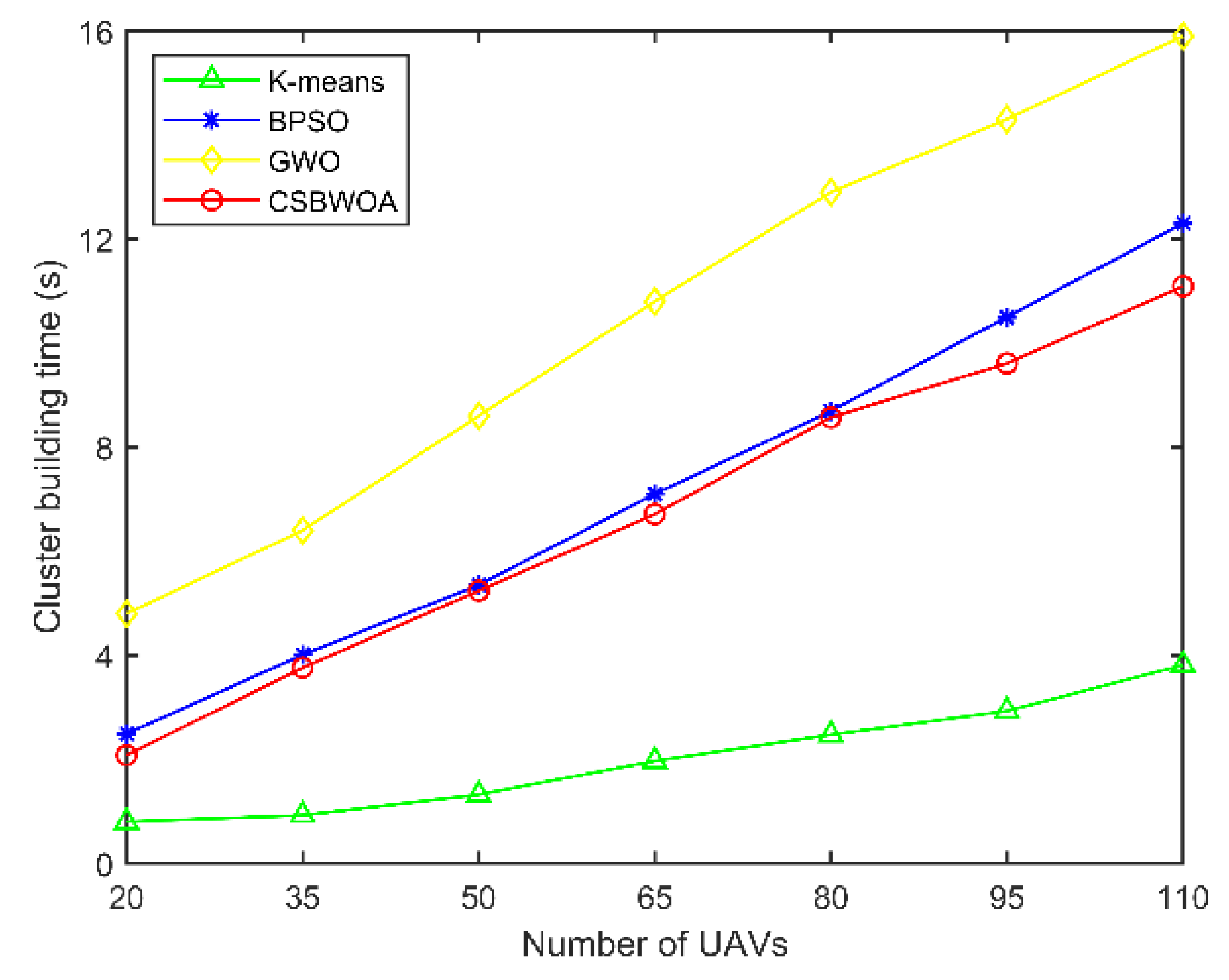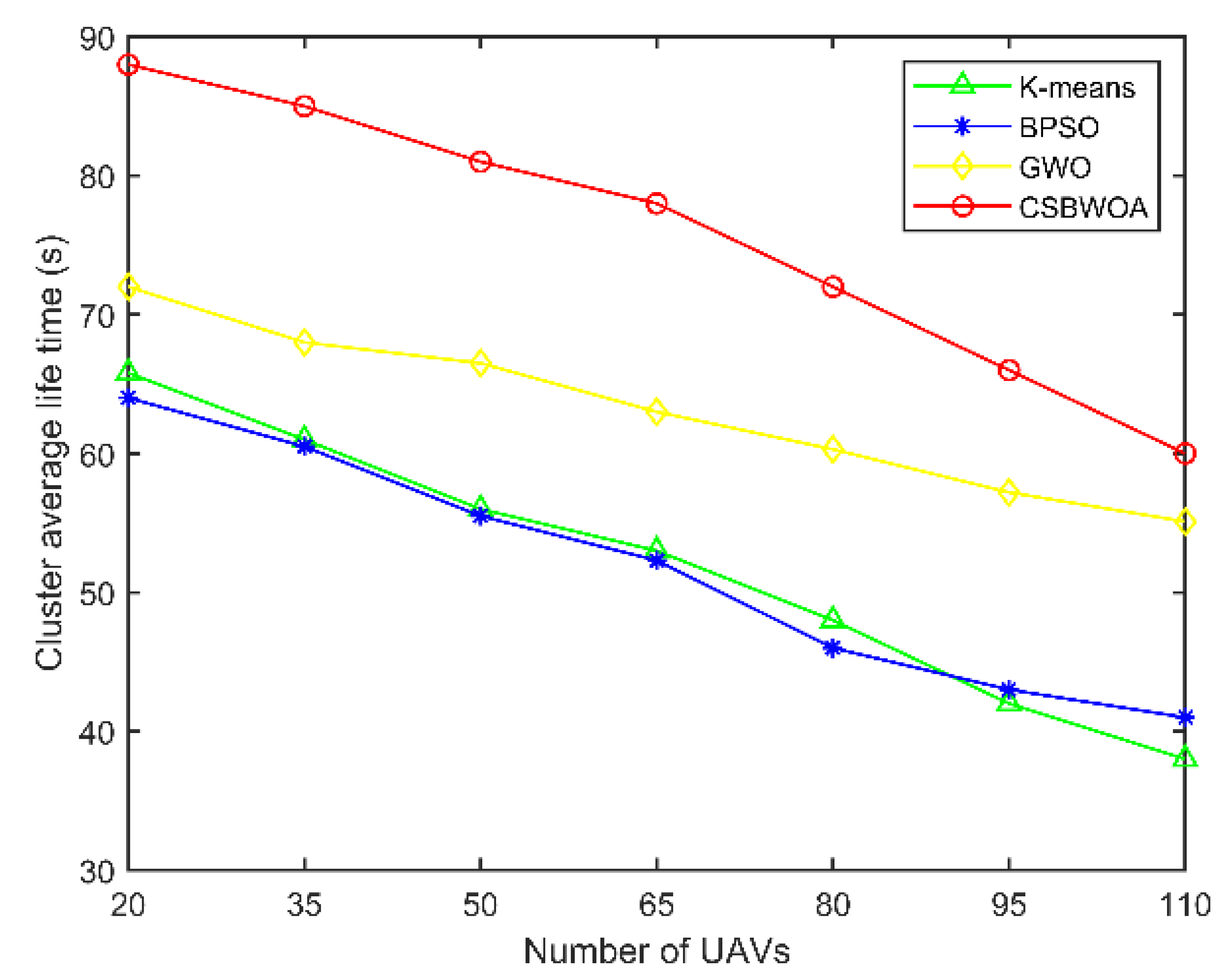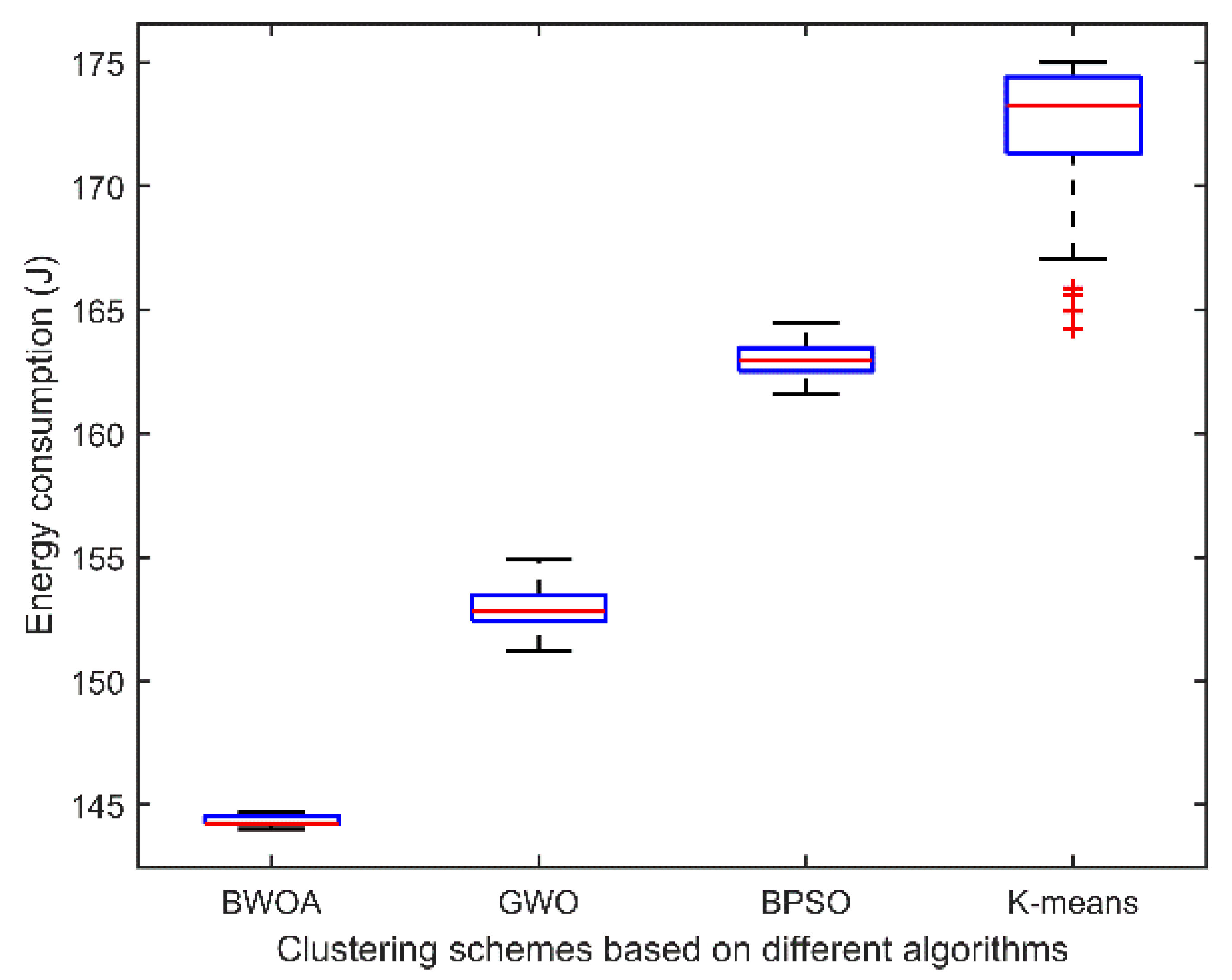A Clustering Scheme Based on the Binary Whale Optimization Algorithm in FANET
Abstract
1. Introduction
2. Related Work
- To reasonably make full use of network resources, this paper calculates the optimal number of clusters to be divided in the network based on the network bandwidth and node coverage capacity to maximize the utilization of network resources.
- A clustering scheme based on the binary whale optimization algorithm (CSBWOA) is proposed. Since the whale optimization algorithm has the advantages of simple operation, few parameters to adjust, and a strong ability to jump out of the local optimum, the discrete binary whale optimization (BWOA) algorithm is used for CH selection in this paper. This algorithm selects cluster heads based on the fitness functions of residual energy, intra-cluster distance, and inter-cluster distance to make the cluster lifetime longer. Multi-hop routing is used for communication between clusters to reduce energy consumption.
3. System Model
3.1. Network Model
3.2. Energy Model
3.3. WOA Algorithm
3.3.1. Standard WOA Algorithm
- Encircling prey:The current best candidate solution is assumed to be the target prey or close to the optimal solution. After defining the best candidate solution, other search agents will try to move towards the optimal location and update their positions. The mathematical model is as follows:where t is the current number of iterations; denotes the position vector of the optimal solution so far; X(t) denotes the position vector of the current solution; and A and C are coefficient variables, calculated by the following equation:where r is a random vector in [0, 1]; is the maximum number of iterations.
- 2.
- Bubble-net attacking method:The whale swims in a spiral motion towards its prey while also shrinking the encirclement. It is assumed that there is a 50% probability of choosing between the shrinking encircling mechanism or the spiral model to update the whale’s position during the optimization process. The mathematical model is as follows:D′ denotes the distance between the current search agent and the current optimal solution; b is a constant defining the shape of the logarithmic spiral; l is a random number between [−1, 1]; p is a random number between [0, 1], i.e., the probability of showing the occurrence of the two behaviors.
- 3.
- Search for prey:When |A| < 1, the whale attacks its prey, demonstrating local search capability. When |A| > 1, the WOA algorithm performs a global search for superiority. To ensure that all whales can fully search in the solution space, a search agent is randomly selected, and the positions of other whales are updated according to the randomly selected whale positions, thus achieving a random search.where denotes the randomly selected whale position vector.
3.3.2. The Binary WOA Algorithm
- Shrinking encircling mechanismThe probability function is calculated as follows:A and are calculated using Equations (8) and (10) in the standard algorithm, and is theprobability to determine if the bit value should be switched. The position of the search agent is modified as follows:is a uniform random number in [0, 1], and denotes the complementary operation.
- 2.
- Spiral update positioncan be calculated using the following probability mapping function.A are computed by the standard Algorithms (8) and (14). The position in the spiral update position mechanism is calculated as follows:
- 3.
- Search for preyThe probability is calculated as follows:A are computed by the standard Algorithms (8) and (15). As a result, the location of the search agent is updated as follows:
4. Scheme Description
4.1. Optimal Number of Cluster Heads
4.1.1. Coverage Analysis
4.1.2. Bandwidth Analysis
4.2. Cluster Formation
4.2.1. CH Selection Based on BWOA
| Algorithm 1: CH Selection Based on BWOA |
| Input:, i = 1, 2, …, N. |
| Output: Cluster head , j = 1, 2, …, K. |
| /* Initialization phase*/ |
| . |
| . |
| 3: Calculate the fitness of each whale. |
| /* Computation*/ |
| 5: while ), do |
| 6: for each search agent, do |
| 7: Update A, C and a by (10)–(12). |
| 8: if p < 0.5 then |
| 9: if then |
| by (17). |
| 11: Update the position X based on (18). |
| 12: else |
| by (15) and (16). |
| by (21) and the position X by (22). |
| 15: end if |
| 16: else |
| by (19). |
| 18: Update the position X by (20). |
| 19: end if |
| 20: end for |
| 21: Calculate the fitness of each search agent by (39). |
| of the best search agent. |
| 23: t = t + 1 |
| 24: end while |
| 25: return CHs |
| Algorithm 2: Cluster Formation |
| Input:, i = 1, 2, …, j = 1, 2, …, K. |
| Output: Cluster , j = 1, 2, …, K. |
| 1: for each do |
| 2: Compute (the distance between the UAV and all CH within its communication range) |
| 3: if the UAV has a minimum distance from then |
| 5: end if |
| 6: end for |
| , j = 1, 2, …, K. |
4.2.2. Cluster Management Phase
- Set the energy threshold for CH, and periodically check the node energy. If it is lower than this value or CH leaves the cluster, then perform cluster maintenance and re-execute Algorithms 1 and 2.
- If the CM leaves the cluster, the node is removed from the list of members of that cluster.
4.3. Routing Mechanism
5. Simulation Results and Analysis
- A.
- Benefits of Clustering
- B.
- Cluster Building Time
- C.
- Cluster Lifetime
- D.
- Energy Consumption and Number of Rounds
- E.
- Node Survival Rate and Number of Rounds
6. Conclusions
Author Contributions
Funding
Institutional Review Board Statement
Data Availability Statement
Conflicts of Interest
References
- Lakew, D.S.; Sa’Ad, U.; Dao, N.N.; Na, W.; Cho, S. Routing in Flying Ad Hoc Networks: A Comprehensive Survey. IEEE Commun. Surv. Tutor. 2020, 22, 1071–1120. [Google Scholar] [CrossRef]
- Zhao, N.; Lu, W.; Sheng, M.; Chen, Y.; Tang, J.; Yu, F.R.; Wong, K.K. UAV-assisted emergency networks in disasters. IEEE Wirel. Commun. 2019, 26, 45–51. [Google Scholar] [CrossRef]
- Qu, Y.; Zhang, F.; Wu, X.; Xiao, B. Cooperative geometric localization for a ground target based on the relative distances by multiple UAVs. Sci. China Inf. Sci. 2019, 62, 10204. [Google Scholar] [CrossRef]
- Schneider, D. Air traffic control for delivery drones [Top Tech 2017]. IEEE Spectr. 2017, 54, 32–33. [Google Scholar] [CrossRef]
- Braverman, A. Unmanned aerial systems (UAS) in urban search and rescue-methodology, capacity development, and integration. J. Emerg. Manag. 2021, 19, 33–38. [Google Scholar] [CrossRef] [PubMed]
- Aadil, F.; Raza, A.; Khan, M.F.; Maqsood, M.; Mehmood, I.; Rho, S. Energy aware Cluster based Routing in Flying Ad-hoc Networks. Sensors 2018, 18, 1413. [Google Scholar] [CrossRef]
- Bhandari, S.; Wang, X.; Lee, R. Mobility and Location-aware Stable Clustering Scheme for UAV Networks. IEEE Access 2020, 8, 106364–106372. [Google Scholar] [CrossRef]
- Medani, K.; Guemer, H.; Aliouat, Z.; Harous, S. Area Division Cluster-based Algorithm for Data Collection over UAV Networks. In Proceedings of the 2021 IEEE International Conference on Electro Information Technology (EIT), Mt. Pleasant, MI, USA, 13–15 May 2021. [Google Scholar]
- Yang, X.W.; Yu, T.Q.; Chen, Z.Y.; Yang, J.F.; Hu, J.L.; Wu, Y.R. An Improved Weighted and Location-Based Clustering Scheme for Flying Ad Hoc Networks. Sensors 2022, 22, 3236. [Google Scholar] [CrossRef]
- Khan, A.; Aftab, F.; Zhang, Z. BICSF: Bio-Inspired Clustering Scheme for FANETs. IEEE Access 2019, 7, 31446–31456. [Google Scholar] [CrossRef]
- Khan, A.; Khan, S.; Fazal, A.S.; Zhang, Z.; Abuassba, A.O. Intelligent cluster routing scheme for flying ad hoc networks. Sci. China Inf. Sci. 2021, 64, 76–89. [Google Scholar] [CrossRef]
- Arafat, M.Y.; Moh, S. Localization and Clustering Based on Swarm Intelligence in UAV Networks for Emergency Communications. IEEE Internet Things J. 2019, 6, 8958–8976. [Google Scholar] [CrossRef]
- Arafat, M.Y.; Moh, S. Bio-Inspired Approaches for Energy-Efficient Localization and Clustering in UAV Networks for Monitoring Wildfires in Remote Areas. IEEE Access 2021, 9, 18649–18669. [Google Scholar] [CrossRef]
- Asaamoning, G.; Mendes, P.; Magaia, N. A Dynamic Clustering Mechanism with Load-Balancing for Flying Ad Hoc Networks. IEEE Access 2021, 9, 158574–158586. [Google Scholar] [CrossRef]
- Ghazzai, H.; Ghorbel, M.B.; Kadri, A.; Hossain, M.J. Energy efficient 3D positioning of micro unmanned aerial vehicles for underlay cognitive radio systems. In Proceedings of the 2017 IEEE International Conference on Communications (ICC), Paris, France, 21–25 May 2017. [Google Scholar]
- Heinzelman, W.R.; Chandrakasan, A.; Balakrishnan, H. Energy-efficient communication protocol for wireless microsensor networks. In Proceedings of the Hawaii International Conference on System Sciences, Maui, HI, USA, 7 January 2000. [Google Scholar]
- Mirjalili, S.; Lewis, A. The Whale Optimization Algorithm. Adv. Eng. Softw. 2016, 95, 51–67. [Google Scholar] [CrossRef]
- Macedo, M.; Siqueira, H.; Figueiredo, E.; Santana, C.; Lira, R.C.; Gokhale, A.; Bastos-Filho, C. Overview on Binary Optimization Using Swarm-Inspired Algorithms. IEEE Access 2021, 9, 149814–149858. [Google Scholar] [CrossRef]
- Reddy, K.S.; Panwar, L.; Panigrahi, B.K.; Kumar, R. Binary whale optimization algorithm and its application to unit commitment problem. Neural Comput. Appl. 2018, 2, 293–328. [Google Scholar]
- Pham, Q.V.; Mirjalili, S.; Kumar, N.; Alazab, M.; Hwang, W.J. Whale Optimization Algorithm with Applications to Resource Allocation in Wireless Networks. IEEE Trans. Veh. Technol. 2020, 69, 4285–4297. [Google Scholar] [CrossRef]
- Basset, M.A.; Shahat, D.E.; Sangaiah, A.K. A modified nature inspired meta-heuristic whale optimization algorithm for solving 0–1 knapsack problem. Int. J. Mach. Learn. Cybern. 2019, 10, 495–514. [Google Scholar] [CrossRef]
- Cao, Y.X.; Li, Y.B.; Xu, M.X.; Peng, H.F. Clustering Algrothrim of WSN Based on Binary Particle Swarm Optimization. Microelectron. Comput. 2015, 32, 147–151. [Google Scholar]
- Daneshvar, S.; Mohajer, P.A.A.; Mazinani, S.M. Energy-Efficient Routing in WSN: A Centralized Cluster-Based Approach via Grey Wolf Optimizer. IEEE Access 2019, 7, 170019–170031. [Google Scholar] [CrossRef]
- Raza, A.; Khan, M.F.; Maqsood, M.; Bukhari, B.H.; Aadil, F. Adaptive K-means clustering for flying ad-hoc networks. KSII Trans. Internet Inf. Syst. 2020, 14, 2670–2685. [Google Scholar]
- Zheng, L.; Ni, M.; Cai, L. Performance analysis of group-synchronized DCF for dense IEEE 802.11 networks. IEEE Trans. Wirel. Commun. 2014, 13, 6180–6192. [Google Scholar] [CrossRef]









| Proposals | Selection of Cluster Head | Cluster Building Time | Cluster Lifetime | Energy Consumption | Survival Rate | ||
|---|---|---|---|---|---|---|---|
| Distance | Energy | Load Balancing | |||||
| EALC [6] | Y | Y | N | Y | Y | Y | N |
| MLSC [7] | Y | N | N | N | N | N | N |
| SAD-CA [8] | N | N | N | N | Y | Y | N |
| IWLC [9] | Y | Y | Y | N | Y | Y | N |
| BICSF [10] | N | Y | N | Y | Y | Y | N |
| CRSF [11] | Y | Y | N | N | Y | Y | N |
| SIC [12] | Y | Y | N | Y | Y | Y | Y |
| BIC [13] | Y | Y | Y | Y | Y | Y | Y |
| DCM [14] | Y | Y | N | N | N | Y | N |
| CSBWOA | Y | Y | Y | Y | Y | Y | Y |
| Parameters | Value |
|---|---|
| Network simulation | MATLAB |
| Simulation area | 2000 m × 2000 m × 500 m |
| Number of UAVs | 20~110 |
| Number of ground stations | 1 |
| Transmission frequency | 2.4 GHz |
| Communication standard | IEEE 802.11n |
| UAV transmission range | 300 m |
| Minimum distance between UAVs | 10 m |
| Initial energy | 5 J |
| Rounds | 1000 |
| Data packet | 50 KB |
| Number of iterations | Variable |
| Number of runs | 30 |
Publisher’s Note: MDPI stays neutral with regard to jurisdictional claims in published maps and institutional affiliations. |
© 2022 by the authors. Licensee MDPI, Basel, Switzerland. This article is an open access article distributed under the terms and conditions of the Creative Commons Attribution (CC BY) license (https://creativecommons.org/licenses/by/4.0/).
Share and Cite
Yan, Y.; Xia, X.; Zhang, L.; Li, Z.; Qin, C. A Clustering Scheme Based on the Binary Whale Optimization Algorithm in FANET. Entropy 2022, 24, 1366. https://doi.org/10.3390/e24101366
Yan Y, Xia X, Zhang L, Li Z, Qin C. A Clustering Scheme Based on the Binary Whale Optimization Algorithm in FANET. Entropy. 2022; 24(10):1366. https://doi.org/10.3390/e24101366
Chicago/Turabian StyleYan, Yonghang, Xuewen Xia, Lingli Zhang, Zhijia Li, and Chunbin Qin. 2022. "A Clustering Scheme Based on the Binary Whale Optimization Algorithm in FANET" Entropy 24, no. 10: 1366. https://doi.org/10.3390/e24101366
APA StyleYan, Y., Xia, X., Zhang, L., Li, Z., & Qin, C. (2022). A Clustering Scheme Based on the Binary Whale Optimization Algorithm in FANET. Entropy, 24(10), 1366. https://doi.org/10.3390/e24101366






